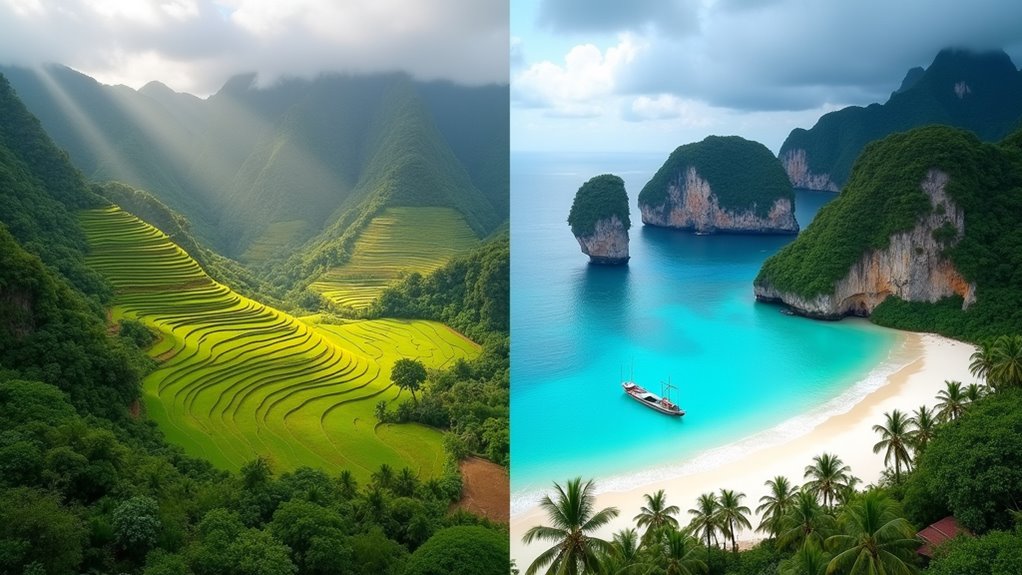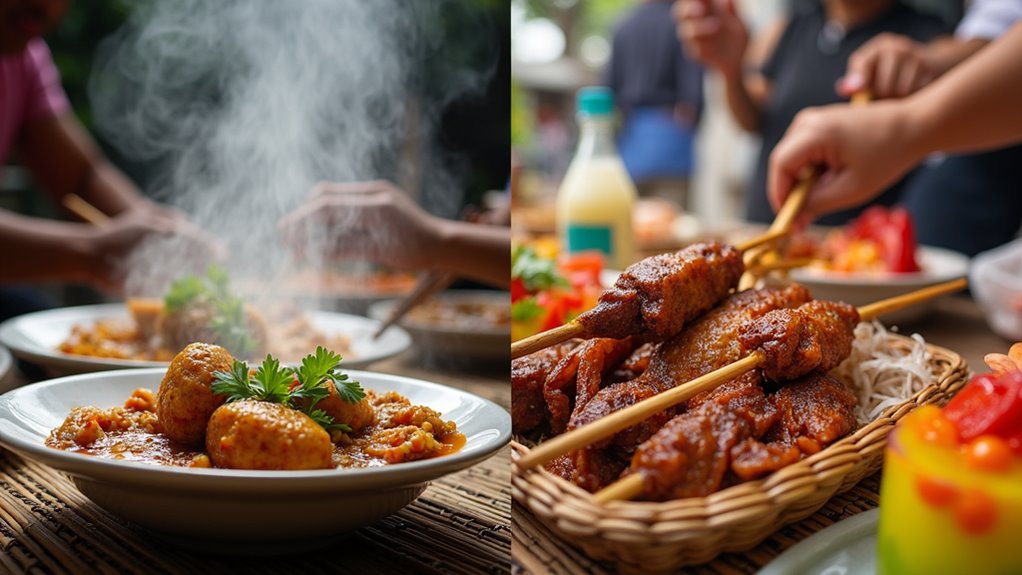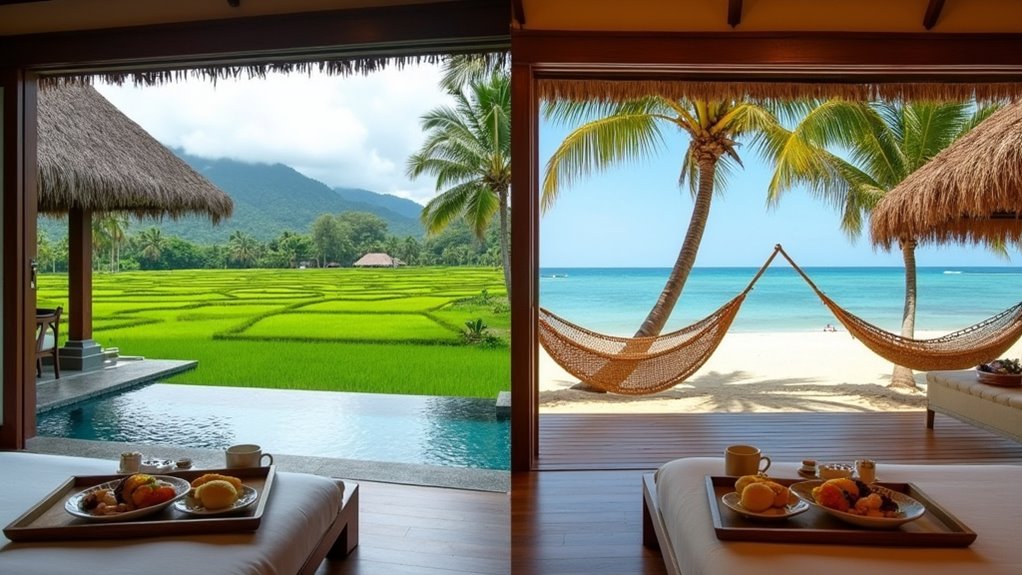Physical Address
304 North Cardinal St.
Dorchester Center, MA 02124
Physical Address
304 North Cardinal St.
Dorchester Center, MA 02124

Oscillating between Indonesia's cultural riches and the Philippines' pristine beaches? Discover which tropical paradise truly deserves your vacation days.
Indonesia offers ancient temples, diverse cultures, and superior tourism infrastructure with better land transportation and accommodations in Bali. The Philippines provides pristine beaches, more affordable lodging, English-speaking locals, and island-hopping adventures. Choose Indonesia for culture, volcanoes, and world-class diving in Raja Ampat, or the Philippines for budget-friendly beach paradises in Boracay and El Nido. Your ideal destination depends on whether you value cultural opulence or affordable tropical escapes.
When choosing between Indonesia and the Philippines for natural attractions, you’re fundamentally deciding between scale and accessibility. Indonesia dominates with sheer diversity—120+ active volcanoes, rainforests covering 50% of its land, and Raja Ampat’s unparalleled marine ecosystems.
The Philippines counters with exceptional quality in specific locations. Boracay’s powdery white beaches and El Nido’s dramatic limestone formations provide postcard-perfect scenery, while Palawan’s protected coral reefs outshine Bali’s degrading underwater landscapes. The comparison between Boracay vs Palawan is itself a common dilemma for travelers seeking the ideal island escape. The country also offers world-class diving experiences at Tubbataha Reef and other renowned diving spots showcasing tremendous marine biodiversity.
For rainforest experiences, Indonesia’s Sumatra and Borneo clearly win with orangutan habitats and UNESCO sites. Volcano enthusiasts will appreciate Indonesia’s trekking routes around Mount Bromo, though the Philippines’ perfectly conical Mayon offers the more iconic silhouette.
While both Southeast Asian nations boast prosperous cultural tapestries, Indonesia and the Philippines offer markedly different historical experiences. Indonesia’s Hindu-Buddhist monuments like Borobudur and Prambanan stand in stark contrast to the Philippines’ Spanish colonial architecture in Vigan.
Explore contrasting cultural treasures: Indonesia’s ancient Hindu-Buddhist wonders versus Philippines’ Spanish colonial splendor.
You’ll discover Indonesia’s abundant gamelan music traditions and iconic Balinese dances (Legong and Kecak), while the Philippines presents Tinikling dances and kulintang musical heritage. The cultural diversity found in these destinations makes them both fascinating alternatives to other Southeast Asian countries like Malaysia.
Traditional stilt houses can be found in both nations, though Indonesia’s Rumah Gadang and the Philippines’ torogan showcase distinct regional styles.
Indonesia’s mainly Muslim culture (with Hindu-dominated Bali) differs greatly from the Philippines’ Christian influences.
For UNESCO World Heritage sites, Indonesia leads with 10 sites while the Philippines has preserved six officially recognized locations, offering visitors different historical and ecological experiences. Indonesia offers ancient temples and wildlife reserves, while the Philippines counters with spectacular rice terraces and historic towns.

The culinary landscapes of Indonesia and the Philippines offer distinctly different gastronomic adventures for foodies. Indonesia edges ahead with its globally recognized street food culture and diverse regional specialties.
While Filipino cuisine delivers exceptional dishes like lechon and adobo, Indonesia’s satay, nasi goreng, and sumptuous peanut sauces create an unmatched flavor profile. Indonesia’s popular street snack “betamax” showcases coagulated chicken blood uniquely shaped into black pipettes.
When visiting Indonesia, travelers should be aware of certain cultural etiquette to ensure they have a respectful and enjoyable culinary experience.
Beyond the enticing food scenes, your travel experience in both countries hinges considerably on how easily you can navigate their diverse landscapes. Indonesia’s infrastructure edges ahead with substantial government investment in its Super-Priority Destinations like Borobudur and Lake Toba. This development is part of a comprehensive effort that has improved water access for 570,000 people and sanitation facilities for 470,000 residents in supported tourism areas by 2024.
You’ll benefit from visa-on-arrival access if you’re from one of 92 countries, simplifying entry procedures.
The Philippines struggles with inter-island connectivity due to its fragmented geography, often requiring combinations of ferries and small aircraft to reach destinations. When considering alternative destinations in Southeast Asia, many travelers compare the Philippines vs Vietnam for ease of travel and infrastructure quality.
Indonesia’s domestic flights prioritize Java-Bali routes, leaving eastern regions like Papua underserved.
Both countries have urban congestion, but Indonesia’s MRT expansions in Jakarta and pedestrian improvements across six destinations offer more comfortable navigation for travelers than the Philippines’ traffic-choked cities.

Choosing where to rest your head after a day of exploration considerably impacts both your comfort and budget when traveling through these island nations. The Philippines tends to offer cheaper hostels starting around $25 per night, while Indonesia delivers better mid-range value, especially outside Bali’s tourist hotspots. In Bali, you can enjoy luxury hotels with spacious rooms and pools for approximately $62 per night.
If you’re seeking alternatives, neighboring Laos offers authentic homestays with remarkably hospitable locals at budget-friendly rates.
Consider your travel style – budget backpackers will stretch their money further in the Philippines, while mid-range travelers might find better value in Indonesia.
Millions of travelers flock to both Indonesia and the Philippines annually, but your experience will differ markedly between these archipelago nations. Indonesia attracts considerably more visitors—targeting 14-16 million in 2025 compared to the Philippines’ more modest numbers.
Explore contrasting worlds: Indonesia’s booming tourism outpaces the Philippines’ more intimate experience.
In Indonesia, you’ll discover Bali’s temples, Java’s Borobudur, and witness orangutans in Borneo’s rainforests.
The Philippines offers Spanish colonial charm in Intramuros and indigenous traditions at Ifugao rice terraces.
For nature lovers, Indonesia boasts volcanic landscapes and Raja Ampat’s marine biodiversity, while the Philippines showcases Palawan’s lagoons and Chocolate Hills. Nearby Laos offers a different adventure with Vang Vieng providing a serene riverside escape for those looking to extend their Southeast Asian journey.
Indonesia’s better transport network makes island-hopping easier than the Philippines’ ferry-dependent system. Both destinations saw steady growth in tourism spending from 2017-2019 before experiencing a dramatic decline in 2020.
Indonesia is rebounding more aggressively, particularly targeting Chinese travelers, while the Philippines focuses on niche markets like medical tourism.
Both Indonesia and Philippines offer incredible experiences, but you’ll get more bang for your buck in Indonesia. It’s no coincidence that Indonesia sees nearly twice as many international visitors annually. With better tourism infrastructure and more diverse landscapes, Indonesia edges ahead. That said, if you’re seeking untouched beaches and warm hospitality, the Philippines won’t disappoint. Your perfect destination depends entirely on what you prioritize in your travel adventure.